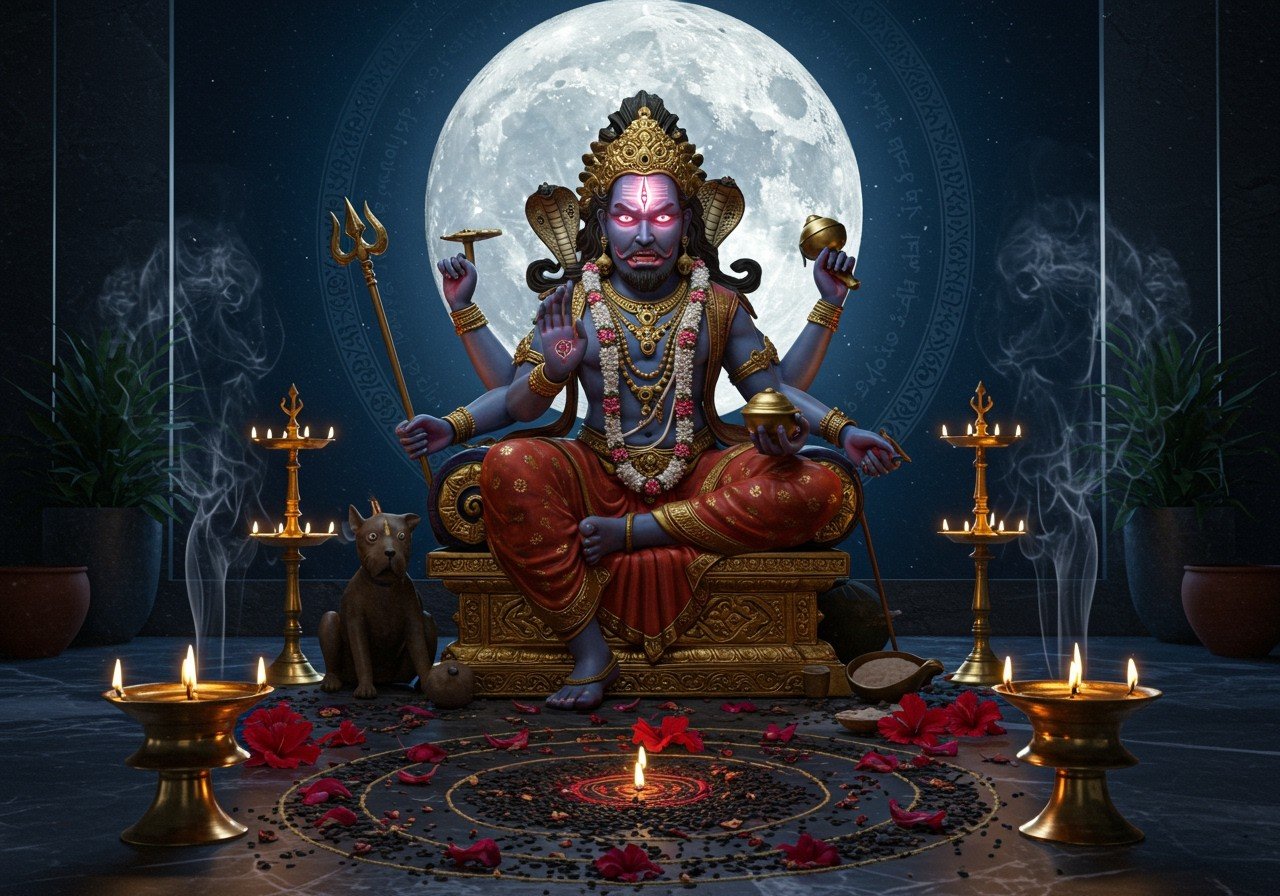
Bhairava worship, a revered practice in the Hindu tradition, embodies the power to overcome fears and obstacles. As a fierce manifestation of Lord Shiva, Bhairava is venerated for his protective and transformative qualities. In 2025, we see more and more culturally rooted Indians embracing Bhairava worship within the sanctity of their homes, seeking spiritual solace and protection. The convenience of authentic ritual items now readily available online through platforms like poojn.in has made performing these sacred rituals more accessible than ever before.
Delving into the Essence of Bhairava
Bhairava, a potent aspect of Lord Shiva, is deeply intertwined with Hindu cosmology as the guardian of the universe. His mythology, originating from ancient scriptures, speaks volumes about strength and vigilance. He manifests in various forms, collectively known as the Ashta Bhairavas, each possessing unique attributes and blessings:
- Kala Bhairava: The controller of time and destiny, symbolizing the cyclical nature of existence and the importance of living in the present moment.
- Swarna Akarshana Bhairava: The attractor of wealth and prosperity, reminding us of the importance of both material and spiritual abundance in a balanced life.
- Asitanga Bhairava: The remover of negativity and nurturer of spiritual growth, signifying the continuous journey of self-improvement and the pursuit of inner peace.
Selecting the appropriate form of Bhairava for worship hinges on individual needs and aspirations. Each manifestation offers specific benefits, allowing devotees to align their worship with their life’s goals and seek blessings relevant to their current circumstances.
A Reverent Guide to Home Worship of Bhairava
Embracing Bhairava worship at home unveils a pathway to spiritual evolution and divine protection. Let’s explore a simplified guide, imbued with reverence and respect, to commence your devotional journey.
Preparing for the Sacred Ritual
- Creating Your Sacred Space: Choose a peaceful and clean corner in your home, a sanctuary dedicated to connecting with Bhairava’s energy. This space should be free from distractions and conducive to contemplation.
- Setting up Your Altar: Place a picture or an idol of Bhairava on a small altar. Remember, an idol is not essential; a heartfelt connection is paramount. A clean, raised platform draped with a clean cloth can serve as your altar.
- The Significance of Direction: Face either east or north during your worship. In Hindu tradition, these directions are considered auspicious and enhance the flow of positive energy.
- Purity of Mind and Body: Bathe and dress in clean attire before commencing the puja. This act of purification signifies respect for the divine and prepares you for spiritual communion.
- Auspicious Timings: Sundays, as well as Kala Bhairava Ashtami, are considered particularly auspicious for Bhairava worship. These times are believed to amplify the positive vibrations of your devotion.
Gathering the Essential Items
- Image or Idol: The focal point of your altar, representing Bhairava’s presence.
- Diya (Oil Lamp): Traditionally filled with mustard oil and made of clay, brass, or silver, symbolizing the dispelling of ignorance and the illumination of knowledge.
- Incense Sticks: Preferably Loban, to purify the atmosphere and create a sacred ambiance.
- Copper Pot with Water: Essential for purification rituals, symbolizing cleansing and renewal.
- Offerings: Jaggery, black sesame seeds, mustard oil, and coconut are traditional offerings. These symbolize sweetness, prosperity, and purity.
- Aasan (Cloth for Seating): Preferably red, as it symbolizes energy and devotion. This cloth provides a clean and designated space for your practice.
- Flowers: Fresh, vibrant flowers, especially red ones, are offered as a symbol of beauty and devotion.
You can find all the necessary items, authentic and high-quality, right here at poojn.in. We offer a wide selection of diyas, holy books, and other decorative items to enhance your home worship experience.
Performing the Puja with Devotion
- Purification (Achamana): Begin by holding water in your right palm, chanting “Om Keshavaya Namah,” and sipping the water. Repeat this process with “Om Narayane Namah” and “Om Madhavaye Namah.” Clean your hand and pour water onto the ground, chanting “Om Govindaye Namah” and “Om Vishnuve Namah,” seeking purification of your surroundings. This ritual purifies the body, mind, and surroundings, preparing for the divine presence.
- Invoking Lord Ganesha: Chant “Om Ganpataye Namah” to invoke Lord Ganesha, the remover of obstacles, ensuring a smooth and blessed puja.
- Lighting the Diya: Light the lamp while chanting “Om Deepa Devtabhyo Namah,” signifying the illumination of knowledge and the dispelling of darkness. Pray for the flame to remain steady and bright throughout the puja.
- Ringing the Bell (Optional): If you have a bell, ring it gently while chanting “Om Ghanta Devatabhyo Namah,” believing it purifies the surrounding environment and invites positive energies.
- Meditation and Seeking Permission: Meditate on Bhairava’s form, seeking his divine permission to begin the worship. This act of reverence establishes a connection with the deity.
- Abhishekam (Ceremonial Bath): Offer curd, honey, milk, or holy water to the idol, if you have one, visualizing the purification of your thoughts and intentions. This symbolic bathing ritual signifies cleansing and renewal.
- Making Offerings: Present fresh flowers and light incense sticks. These offerings symbolize respect, devotion, and gratitude.
- Chanting Mantras: Recite mantras dedicated to Bhairava, such as “Om Bhairavaya Namah,” 108 times using a mala (prayer beads). The Kala Bhairava Ashtakam can also be recited for deeper spiritual connection.
- Naivedya (Food Offering): Offer freshly prepared fruits, sweets, or simple home-cooked dishes like rice or kheer (rice pudding) with utmost reverence. This offering symbolizes sharing the fruits of your labor with the divine.
- Offering Prayers: Express your heartfelt prayers, seeking protection, guidance, prosperity, and blessings from Bhairava.
- Aarti: Perform the Kaal Bhairav Aarti, a traditional concluding ritual expressing gratitude and reverence.
- Post-Aarti Meditation: After the aarti, spend a few moments in quiet contemplation, reflecting on Bhairava’s presence and absorbing the positive energy.
- Concluding Prayer and Gratitude: Offer a final prayer of gratitude, acknowledging Bhairava’s blessings and seeking continued guidance and protection. Pray for peace, security, and success in all endeavors.
- Honesty and Sincerity: Approach Bhairava with honesty and sincerity in your heart. True devotion is the key to a deeper connection. Your intentions and sincerity are more important than elaborate rituals.
- Fasting as a Form of Devotion: Some devotees choose to observe fasts, especially on Kala Ashtami, as a mark of reverence and spiritual discipline. Fasting is a personal choice and should be undertaken with consideration for one’s health.
- Consistency in Worship: Begin your practice on an auspicious day, such as Krishna Paksha Ashtami, Shukla Paksha Ashtami, Friday, or Sunday, and aim for consistency in your worship for sustained spiritual growth. Regularity strengthens your connection with the divine.
- Bhairava Ashtami: A Special Observance: Bhairava Ashtami, celebrated during Margashirsha (November-December), is a significant festival dedicated to Bhairava. Observe this day with special pujas and rituals to deepen your connection with the deity.
Important Considerations for Your Practice
Embrace these practices with an open heart, allowing Bhairava’s transformative energy to guide you on your spiritual journey. Remember, the sincerity within your heart and the consistency of your practice strengthen your bond with the divine. May Bhairava’s blessings fill your life with peace, prosperity, and protection.
FAQs on Worshipping Bhairava at Home: A Practical Guide for 2025
How can I worship Bhairava at home in a simple yet meaningful way?
Creating a sacred space at home for Bhairava worship doesn’t require elaborate rituals. Start by cleansing the area where you intend to perform the puja. Placing a Bhairava idol or even a simple picture is a beautiful gesture. Offer fresh flowers, light incense, and a diya. Chanting a Bhairava mantra like “Om Hreem Bhairavaya Namah” with sincere devotion adds a powerful spiritual dimension. Conclude with a heartfelt prayer and, if you wish, share prasad. The emphasis is on the purity of your devotion, not the complexity of the ritual.
Which form of Bhairava is most suitable for home worship?
Kalabhairava is frequently worshipped at home. He’s revered as a guardian deity, offering protection from negative energies. The key is to ensure the chosen idol or image is placed in a clean, designated area, treated with utmost respect, and made a focal point for your devotion.
What’s the most effective way to offer prayers to Bhairava?
A simple yet powerful way to pray to Bhairava is by lighting a lamp, offering flowers, and chanting his mantra. Meditating on his form and expressing your wishes and gratitude creates a deeper connection. The sincerity and devotion you bring to the prayer are more important than elaborate rituals.
What essential items do I need for Bhairava worship?
The essential items for Bhairava worship include an idol or picture of Bhairava, fresh flowers, incense sticks, a diya (lamp), turmeric, kumkum, and fruits or sweets for prasad. These items create a sacred atmosphere and symbolize respect and devotion.
Why is Bhairava worship considered important in Hindu tradition?
Worshipping Bhairava is believed to remove obstacles from one’s path, offer protection from negative energies, and pave the way for prosperity. It is also said to cultivate courage and confidence, empowering devotees to face life’s challenges.
Can Bhairava be worshipped daily, or are there specific days?
Bhairava can be worshipped daily. Regular worship is believed to provide continuous protection and blessings. While daily worship is beneficial, Sundays and Ashtami days are considered especially auspicious for connecting with Bhairava’s energy.
Is there a specific time of day considered most auspicious for Bhairava worship?
The midnight hours are traditionally considered most auspicious for Bhairava worship, as he is regarded as the guardian of time. However, early morning prayers are also considered highly effective. Choose a time that aligns with your schedule and allows for focused devotion.
What are the benefits of incorporating Bhairava worship into my home routine?
Worshipping Bhairava at home is believed to bring peace, protection, and prosperity to the household. It can help overcome fears, achieve goals, and maintain harmony within the family. It’s a powerful practice for enhancing spiritual well-being and creating a positive environment.
Start your spiritual journey with Bhairava today. Visit poojn.in to find authentic Bhairava idols, puja items, and more.


